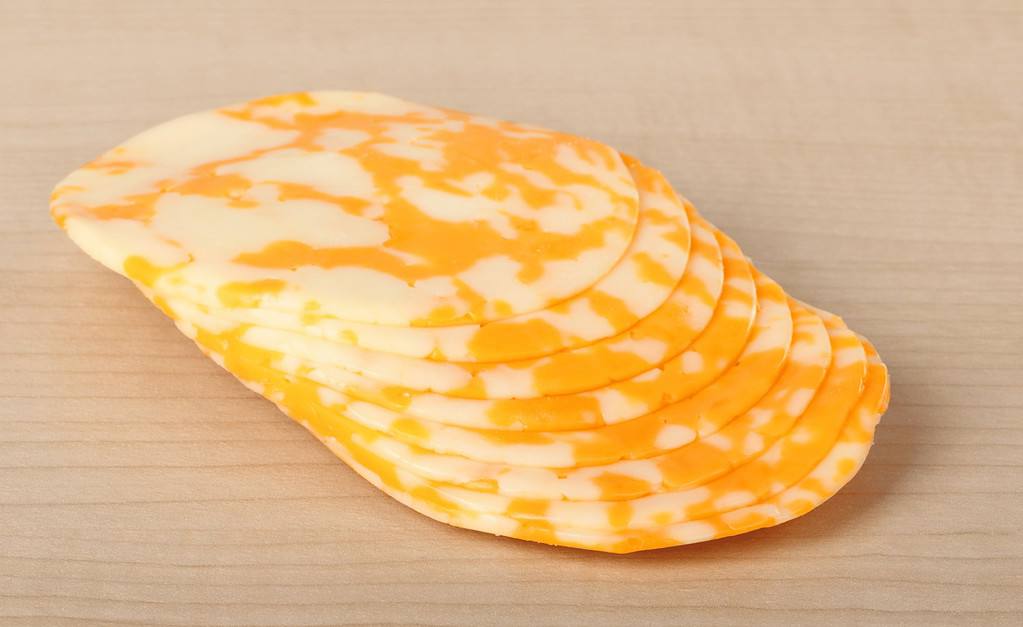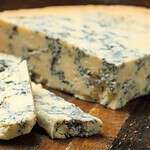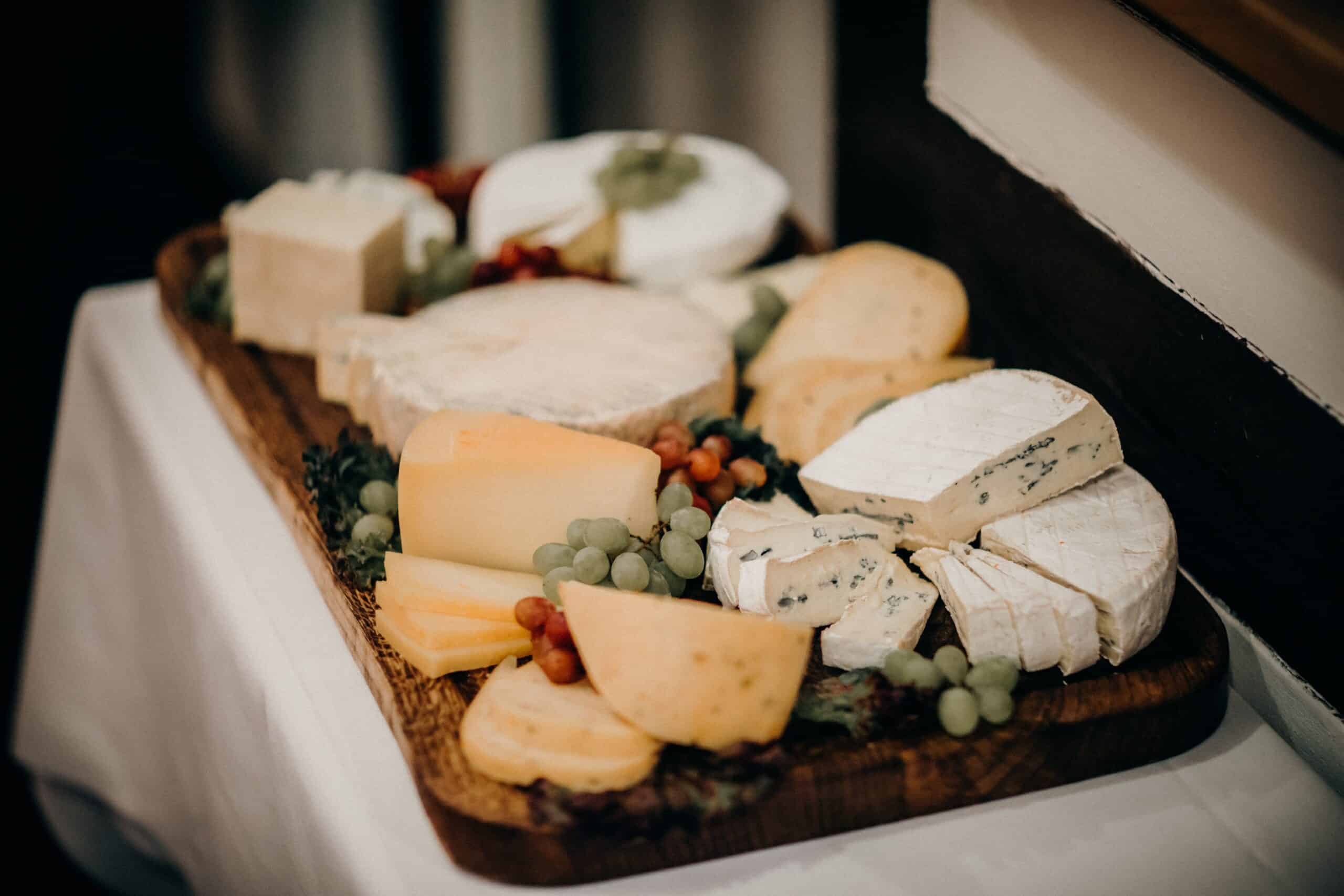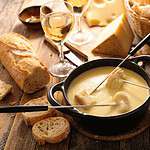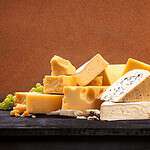Colby Jack cheese, a quintessential American cheese, is a blend of two cheese varieties, Colby and Monterey Jack. Originating in the United States, it has a distinct pattern of marbling that combines the orange hue of Colby with the creamy white of Monterey Jack. This cheese is known for its mild flavor and semi-hard texture, making it a versatile choice in the culinary world.

The making of Colby Jack cheese is a process that reflects the American innovation in cheese production. It originated in Wisconsin, a state famed for its cheese-making traditions, though it’s now produced in various parts of the country, including California. The production involves a washing of the curds that reduces the acidity, resulting in the cheese’s characteristically gentle taste.
Key Takeaways
- Colby Jack is a combined cheese from the US with a soft flavor and marbled look.
- It is birthed from the rich cheese-making traditions of Wisconsin, with its production spread across the US.
- This cheese is versatile in the kitchen, easily found, and has a range of nutritional benefits.
History and Origin
Colby Jack cheese is a classic American cheese with origins deeply rooted in the historical dairy cultures of Wisconsin and California. Its unique flavor and texture are the result of blending two distinct cheese traditions.
Development of Colby Jack
Colby cheese was first created in the late 19th century in Colby, Wisconsin. Joseph F. Steinwand developed this new cheese at his father’s cheese factory by altering the processes used to make cheddar, resulting in a milder, more moist cheese that we now know as Colby. Monterey Jack, on the other hand, has its origins in the Franciscan friars of Monterey, California, during the 19th century. Its further refinement is attributed to businessman David Jacks, who commercialized the cheese, leading to its namesake.
- Colby: Developed in Colby, Wisconsin by Joseph F. Steinwand
- Monterey Jack: Originated with the Franciscan friars of Monterey, California; commercialized by David Jacks
The combination of these two cheeses to create Colby Jack is a relatively recent innovation, giving rise to a cheese that embodies the qualities of both parents. It usually features a marbled mix of Colby and Monterey Jack cheeses.
Influence of Wisconsin Dairy Culture
Wisconsin’s reputation as ‘America’s Dairyland’ is well-established. The state’s dairy tradition has English roots, due to the immigration of skilled cheesemakers from England. Immigrants brought their extensive knowledge and practices to Wisconsin, which became the perfect venue for cheese production owing to its rich pastures and suitable climate. This cultural heritage and abundance of high-quality milk turned Wisconsin into a hub for cheese innovation.
- Dairy Culture: Influenced by England; immigrants brought cheesemaking skills to Wisconsin
- Climate: Wisconsin’s climate and pastures provide ideal conditions for high-quality cheese production
Tradition and innovation in Wisconsin’s dairy culture continue to contribute to the creation of cheeses like Colby Jack.
Pioneers and Innovators
Joseph F. Steinwand is the recognized pioneer behind Colby cheese. His innovative spirit in the 1880s led to the creation of a softer, more elastic cheese than the traditional cheddar. This invention laid the groundwork for a range of derivative cheeses, including Colby Jack. In California, early innovators adapted Spanish techniques and combined them with local conditions to create the Monterey Jack cheese. Since both states have a reputation for high-quality dairy products, the convergence of their respective cheese-making traditions in the form of Colby Jack was almost inevitable.
- Joseph F. Steinwand: Innovated Colby cheese in the 1880s in Wisconsin
- David Jacks: Popularized Monterey Jack cheese in California
Together, these pioneers and others like them in the United States have shaped a landscape in which Colby Jack cheese plays a significant role, representing a true blend of American dairy heritage.
Characteristics of Colby Jack Cheese
Colby Jack cheese is a distinctive variety known for its marbled appearance and balanced flavor profile. We’ll detail its physical attributes, flavor nuances, and the texture and consistency that consumers enjoy.
Physical Attributes
Colby Jack is a visually appealing cheese, marked by its marbled mix of Colby and Monterey Jack cheeses. The exterior shows orange and white areas due to the intertwining of the two cheeses.
Flavor Profile
The flavor of Colby Jack cheese is mild and mellow. The Colby portion offers a gentle sweetness, while the Monterey Jack provides a subtle buttery taste. This combination results in a cheese that’s not overpowering but has enough depth to be memorable.
Texture and Consistency
In terms of texture, Colby Jack is a semi-hard cheese, known for its open texture which makes it remarkably sliceable and meltable. It’s softer and more moist than traditional cheddar, with a creaminess that’s appreciated on a variety of dishes.
Production Process

In creating Colby Jack cheese, a blend of two popular cheeses, we follow a meticulous process that involves specific steps to ensure a smooth, marbled cheese that combines the mild flavors of Colby and Monterey Jack.
Milk Sourcing and Preparations
We source high-quality milk which is paramount for producing Colby Jack cheese with the desired flavor and texture. Upon arrival, we test and pasteurize the milk to eliminate pathogens. Our preparations include the addition of annatto, a natural coloring to give Colby its distinctive hue, and mix it proportionately to maintain consistency between batches.
Curdling and Curd Processing
For curdling, we introduce starter cultures and enzymes such as rennet, initiating the coagulation process. The enzyme’s action separates the milk into curds and whey. During curd processing, we cut the curds into small pieces to expedite whey expulsion then gently cook and stir them. We ensure that Colby has a higher moisture content compared to Monterey Jack by adjusting the temperature and coagulation time.
| Step | Purpose | Factor |
|---|---|---|
| Curd Cutting | Increases the surface area | Facilitates whey expulsion |
| Cooking | Enhances curd firmness | Temperature control is key |
| Stirring | Prevents curd clumping | Ensures consistent texture |
Aging and Maturation
The aging process is critical to developing the distinct flavors of Colby and Monterey Jack before they are combined. Initially, we salt the curds to halt bacterial action and aid in moisture removal. For Colby, the aging is brief, keeping its taste mild. The longer aging of Monterey Jack allows for its richer flavor to mature. Once both cheeses reach their individual peaks, they are combined to form the marbled Colby-Jack, also known as Co-Jack or Cojack. Our controlled aging environments promote consistent results in texture and taste.
| Cheese Type | Aging Duration | Flavor Development |
|---|---|---|
| Colby | Short | Mild |
| Monterey Jack | Longer | Richer |
By closely monitoring each step, from milk preparation to aging, we ensure the production of high-quality Colby Jack cheese that meets our standards and the expectations of cheese lovers.
Nutritional Information and Health Benefits

We’ll explore the nutritional content of Colby Jack cheese and how it can fit into a balanced diet, considering both its calorie count and how it aligns with various dietary needs.
Components and Calories
Colby Jack cheese, a blend of Colby and Monterey Jack cheeses, provides a rich source of essential nutrients. A typical serving size of 1 ounce (28 grams) contains:
- Calories: 110
- Protein: 7 grams
- Fat: 9 grams
- Saturated Fat: 5.5 grams
- Trans Fat: 0 grams
- Cholesterol: 20 mg
- Carbohydrates: 0.5 grams
- Sodium: 170 mg
- Calcium: 200 mg
This cheese is a high-energy food due to its caloric content mostly from fats. It is a good source of protein and calcium, which are important for muscle function and bone health.
Dietary Considerations
Colby Jack cheese fits into various dietary patterns but should be consumed in moderation due to its fat content. For those on a low-carbohydrate or ketogenic diet, this cheese is suitable as it contains minimal carbohydrates.
For individuals watching their cholesterol or fat intake, it’s wise to limit Colby Jack consumption due to its saturated fat and cholesterol content. However, because of its protein and calcium, it can be beneficial within a balanced diet.
Moreover, individuals with lactose intolerance should be cautious as it contains lactose, although typically less than some other cheeses.
For those following a sodium-restricted diet, monitoring portion sizes is critical since this cheese variety has a considerable amount of sodium.
In terms of compatibility with an American cheese diet, Colby Jack is a widely accepted and enjoyed variety in the United States and can complement many traditional American dishes. However, always remember to account for its caloric density when planning your meals.
Culinary Uses

Colby Jack cheese, with its mellow flavor and perfect meltability, fits into a myriad of culinary applications. We’ll discuss how best to incorporate this cheese into various dishes, and also cover proper selection and storage techniques.
Popular Recipes and Pairings
When using Colby Jack cheese in recipes, we often look for dishes where its unique flavor and melting properties can shine.
- Sandwiches & Burgers: A slice of Colby Jack adds a creamy touch to turkey sandwiches or a classic beef burger.
- Quesadillas & Nachos: This cheese melts uniformly, making it ideal for Mexican dishes like quesadillas and nachos.
- Casseroles & Mac and Cheese: Its ability to complement an array of ingredients without overpowering them makes it a top choice for casseroles and macaroni dishes.
- Grilled Cheese Sandwiches: Blend Colby Jack with other cheeses to elevate the flavor of a grilled cheese sandwich.
Notable Pairings:
- Meats: It pairs well with milder meats such as turkey.
- Vegetables: Tomatoes enhance its flavor, especially when used in grilled sandwiches or salads.
- Sauces: Incorporate Colby Jack into sauces for a smooth and creamy consistency.
Cheese Selection and Storage
Selecting the right Colby Jack and storing it properly ensures the best taste and longevity.
Selection:
- Look for cheese that has a uniform color and smooth texture.
- Avoid any pieces with dry edges or discoloration, indicators of improper handling.
Storage:
- Refrigerate: Keep Colby Jack refrigerated, ideally between 34°F and 38°F.
- Wrapping: Wrap loosely in parchment paper then plastic wrap to retain moisture without becoming soggy.
- Shelf Life: Properly stored, Colby Jack can last up to four weeks.
Remember that for optimal flavor, let the cheese come to room temperature before serving, especially when used for snacking or in cheese boards.
Serving Suggestions and Pairings

Colby Jack, a blend of Colby and Monterey Jack cheeses, is a semi-soft cheese that proffers a harmonious melding of flavors suitable for a variety of pairings. We focus on the most complimentary food and beverage combinations to enhance its mildly sweet and accessible taste profile.
Food Combinations
Fruit Pairings:
- Apples: A crisp, sweet apple cuts through the cheese’s creamy texture.
- Pears: The subtle sweetness of pears complements Colby Jack’s mellow flavor.
Cheese Boards:
- Gouda & Havarti: Pair with these cheeses for a nuanced, multi-textured experience.
- Dried Fruits & Nuts: A selection adds sweetness and crunch, highlighting Colby Jack’s versatility.
Beverage Pairings
Beer:
- Lagers: Their crispness contrasts delightfully with the cheese’s softness.
- Pale Ales: Their slight bitterness plays well against the semi-sweetness of the cheese.
Wine (optional):
- A lightly sweet white wine can balance the creamy and gentle tang of Colby Jack.
Buying and Storage Tips
When we purchase Colby Jack cheese and store it correctly, we ensure its smooth flavor and semi-hard texture is preserved for our enjoyment. Below we outline the best practices for both buying and storing this popular cheese.
Purchasing Guide
Colby Jack, renowned for its smooth, marbled blend of Colby and Monterey Jack cheeses, can be found in most grocery stores due to its popularity. When purchasing:
- Look for freshness: Check the sell-by date to ensure maximum freshness.
- Examine the packaging: Ensure the packaging is sealed and intact to prevent contamination.
Preservation Methods
To maintain the optimal quality of Colby Jack cheese:
-
Wrap properly: Store the cheese in wax paper or parchment before placing it in a plastic bag. This allows the cheese to breathe and maintains moisture balance.
-
Use a cheese drawer: If available, place it in a designated cheese drawer in your refrigerator to keep the temperature and humidity consistent.
Following these tips, we can enjoy the full flavor and ideal texture of our Colby Jack cheese for as long as possible.
Substitutes and Alternatives
In this section, we explore alternative cheeses that can replace Colby Jack in recipes, and provide some recommendations for substitutes based on flavor profiles and texture compatibility.
Comparing with Similar Cheeses
Colby Jack cheese is a blend of Colby and Monterey Jack cheeses, offering a milder flavor than sharp cheddar but with a similar, slightly tangy profile. When seeking similar cheeses, we look to those that melt well and provide a creamy and smooth texture. Here’s a brief comparison:
- Cheddar Cheese: Typically sharper in flavor, especially aged varieties. Useful for those seeking a more pronounced taste.
- Monterey Jack Cheeses: These are the base for Colby Jack and offer a creamy, mild taste. They can vary from milder to slightly spicy, like Pepper Jack.
The cheddaring process, unique to making cheddar and some other cheeses, creates a firmer texture than seen in Colby Jack. When choosing a substitute, consider whether the recipe benefits from this firmer texture or from the more meltable nature of Colby Jack.
Substitute Recommendations
We have curated a list of cheese substitutes that you can use in place of Colby Jack.
- For a milder flavor:
- Gouda: Young Gouda can provide a similar texture with a sweet, mild taste.
- Havarti: Creamy and smooth, a good match for the meltability of Colby Jack.
- For a slightly tangy flavor:
- Mild Cheddar: Offers a bit more tanginess without overpowering a dish.
- Edam: Less tangy than Colby Jack but maintains a pleasant flavor profile.
| Cheese Type | Flavor Note | Melting Quality |
|---|---|---|
| Gouda | Mild and sweet | Good |
| Havarti | Mildly buttery | Very good |
| Mild Cheddar | Slightly tangier | Good |
| Edam | Subtle, nutty | Good |
In each case, the substitute cheese should ideally be a versatile cheese that can be used across a broad range of dishes, just like Colby Jack. It’s also important to match the cheese to the dish’s intended flavor and texture profile.
Cultural and Social Aspects
We observe that Colby Jack, a marbled cheese recognized for its intertwining of Colby and Monterey Jack cheeses, has become prominent in various culinary traditions. It holds a special place in American cuisine, and its influence extends globally, accommodating diverse tastes and traditions.
Colby Jack in American Cuisine
Colby Jack cheese, originating from a blend of two American classics, Colby cheese and Monterey Jack, has found its way into the heart of American cuisine. With its mild taste and smooth texture, it’s a popular choice in a variety of dishes, from the simplicity of grilled cheese sandwiches to the complexity of gourmet burgers.
- Tacos and Nachos: Often melted over tacos and nachos, adding a creamy, tangy taste that complements the bold flavors of Mexican-inspired dishes.
- Pizzas: A go-to topping for pizzas, contributing to the melty, irresistible stretch we associate with an ideal slice.
- Burgers: Its adaptability makes it a favored choice for burgers, pairing well with savory meats.
- Salads: Shredded Colby Jack can enhance salads by adding both visual appeal and a rich, savory flavor profile.
Global Popularity and Variations
While Colby Jack cheese is a truly American creation, it has garnered a global following. Variations of this cow’s milk cheese can be found in numerous countries, often adapted to suit local tastes and culinary customs.
- American Cheese Fusion: Internationally, many cheeses borrow the term “American” to invite a sense of familiarity, blending traditional recipes with the creamy characteristics of Colby Jack.
- Culinary Adaptations: In different regions, variations have emerged, using local milking breeds and distinct ripening processes to create cheeses that reflect their unique terroir while paying homage to the heritage of Colby Jack.
- Shared Experiences: As a versatile cheese, it has made its way into international kitchens and is often used in communal dishes that emphasize sharing, such as platters and cheese boards.
Colby Jack’s flavor and appearance, with its distinct marbled look, have transcended its American roots, appealing to cheese-lovers around the world and earning its place on the global cheese stage.
Frequently Asked Questions
In this section, we answer some of the most common queries about Colby Jack cheese, from its production to its nutritional profile and culinary uses.
How is Colby Jack cheese produced?
Colby Jack cheese is a combination of two cheese types: Colby and Monterey Jack. It is made by blending the curds of Colby and Monterey Jack cheeses together before pressing, which leads to the distinctive marbled effect.
What are the main differences between Colby Jack and Cheddar cheese?
Colby Jack often has a milder flavor and is more moist compared to Cheddar, which typically has a sharper taste and a firmer texture. The colors of these cheeses also differ: Cheddar is usually uniformly orange, while Colby Jack features a mix of orange and white hues.
What are some health considerations associated with consuming Colby Jack cheese?
As a dairy product, Colby Jack cheese provides calcium and protein but is also high in saturated fat and sodium. Individuals with dietary restrictions or lactose intolerance should consume it in moderation.
Can you describe the flavor profile of Colby Jack cheese?
The flavor of Colby Jack cheese is mild, mellow, and slightly sweet. It lacks the strong tang of aged cheeses, which makes it a versatile choice for a variety of dishes.
For what culinary applications is Colby Jack cheese particularly well-suited?
Colby Jack cheese melts well, which makes it ideal for grilled sandwiches, burgers, and as a topping for nachos. Its creamy texture also lends itself to being cut into cubes for use in salads and cheese trays.
What cheeses are similar to Colby Jack in taste and texture?
Similar cheeses to Colby Jack include Cheddar Jack, which also blends the textures and flavors of Cheddar and Monterey Jack, and Gouda, for its mild and creamy qualities.

